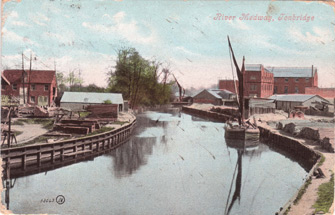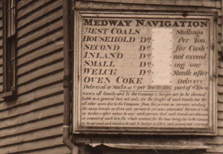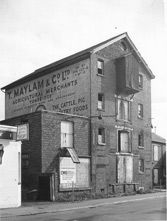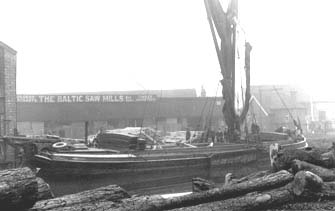1740: The Medway Navigation

A solitary barge is moored at the Medway Wharf in this early 20th-C postcard
view from the Big Bridge in Tonbridge (THS16.109)
Tonbridge grew up where there was a crossing over the river Medway and the
river has always been of crucial importance in the growth and development of the
town. This was particularly so between 1740 and 1911 when the Medway Navigation
Company managed the movement of trade and goods down the river to Maidstone.
The movement of goods in England up to the mid-eighteenth century was very
difficult since the roads were poor and mainly unsurfaced and movement,
particularly of heavy goods, was very slow. This particularly applied to the
roads of the Kent and Sussex Weald which were amongst the worst in the country.
Daniel Defoe in the early eighteenth century recorded that it could take up to
three years to haul a load of timber from the Weald to Chatham and also that a
lady living in a country village near Lewes had to be taken to church in a coach
pulled by six oxen since horses could not cope with the road.
Formation of the Company
The obvious alternative to roads was to improve river navigation to make them
fit for traffic and there were efforts in the seventeenth century to make the
upper Medway navigable above Maidstone, but without success. Finally in 1740,
following a survey of the river in 1739, an Act of Parliament set up the Medway
Navigation Company with the aim of making the Medway navigable from Maidstone to
Forest Row in Sussex (although in practice they never got beyond Tonbridge).
Below Maidstone the river was already navigable.
The formation of the Company was organized by John Hooker, the Lord of the
Manor of Tonbridge and owner of Tonbridge Castle. The aim was to raise £30,000
capital by selling up to 300 shares at £100 each, although it was not fully
subscribed. The first meeting of the Company was held on 20th May 1740, at
the Rose and Crown in Tonbridge.
Construction Work
Work began in January 1741 on making the river navigable, starting from Maidstone and working in sections upstream towards Tonbridge. Up to fourteen
locks were eventually built, most using oak bought at Penshurst and floated
downstream although some of the locks at the Tonbridge end used stone from
Tonbridge Castle. The last payment for work on the Tonbridge lock was made by
the Company on the 30th June 1747 and the total cost for the whole navigation
construction was £11,419 with an extra £1,119 for the wharves.
One major disadvantage was the lack of a towpath suitable for horses to pull the
forty-ton barges, so the work had to be done by teams of men, called ‘hufflers’
or ‘halers’ instead. They took ten to twelve hours to cover the distance between
Tonbridge and Maidstone, scrambling over bridges, hedges and ditches. The work
must have been extremely hard and is perhaps reflected by the records of the
bargemen’s powers of invective. A writer in the 1770s declared ‘most Medway
bargemen are very skilful in this verbal mode of warfare, they use extraordinary
terms and generally, very coarse and dirty ones’. The Company ordered in the
1740s that a fee of 2s 6d (12.5p) was to be imposed on bargemen for immodest,
obscene and lewd expressions!
Trade
Once the river was navigable, the economy of Tonbridge rapidly improved and
developed. The main goods brought upstream were coal, lime and stones whilst
downstream, the main freight was timber, hops and other farm produce from the
Weald.
In Tonbridge a wharf was built on land called the Outfield Mead leased from
George Walter for 999 years together with two houses on the site. The house next
to the Big Bridge got a licence for an inn called initially The Six Bells but
known more familiarly, to this day, as The Castle.

The Navigation Company advertises coal at its High Street Office, before 1888
(THS14A.114)
Coal was a major upstream cargo, much of it coming from the north-east and
probably transferred onto Medway barges at Rochester and Sheerness. The Company
held a near monopoly in this trade as only they could charge a competitive price
since they could impose higher tolls on non-company barges. Stone and lime were
also brought upstream and used for both road making and building. A list of
other products carried on the barges in the first half of the nineteenth century
include: linseed, wheat, rags, soap, tallow, paper, candles, beer, cider,
brandy, slate, cement, vinegar, glass, barley, cheese, sugar, butter, nails and
brimstone.
One significant user of the navigation in the nineteenth century was the
Gunpowder Mills built along the Medway between Leigh and Tonbridge. The first
mills were built in 1813 and expanded during the rest of the nineteenth century.
They used the Navigation to move the gunpowder down river to the firm’s magazine store at
Erith in special barges carrying a red flag to warn of their dangerous cargo.
They were charged 15 shillings (75p) per ton which was more than twice the rate
charged for any other freight. This trade continued until 1874 when it stopped
following complaints from the people of Maidstone who were worried about the
safety of the gunpowder barges.
Development of Tonbridge

Maylam's warehouse in Medway Wharf Road before redevelopment (THS4.107)
The Company’s operations had a big impact on Tonbridge, centred around the
Medway wharf which ran for over a hundred yards downstream from Big Bridge on
the south side of the river where goods would be loaded from carts to barges or
barges to carts. Early maps show a crane, weighing station, coal pens and a lime
kiln (where chalk was converted to lime to make the mortar needed for the
developing building trade). Lads carrying long rows of pots on poles for the
bargees’ beer were a familiar sight in the centre of Tonbridge. The bargees also
used the pub We Three Loggerheads on the High Street, demolished in 1900 and
replaced by the Post Office which is now the Sir Humphrey Bean Wetherspoons pub.
Surviving buildings linked to the navigation include the warehouse of T.
Maylam and Co., agricultural merchants, which has been incorporated into the Maylam's
Quay building in Medway Wharf Road, and Lyons warehouse on the opposite
bank. This was used by Humphrey Wightwick, the High Street tallow chandler,
later by Charlton the miller and then became the Hogshead pub. The Baltic Saw
Mills Company had premises on the Botany side of Medway Wharf road and later
between Lyons Crescent and the river.
Prosperity
The Company prospered for nearly a hundred years after its establishment in
the 1740s due not just to revenue from the tolls charged on freight but
particularly from its direct involvement in the coal trade and the setting up of
lime kilns at Tonbridge. The Company even in 1768 became directly involved in
the iron trade, buying iron in London to the value of nearly £500. In 1790 a
dividend of £10 per share was declared and the chief clerk, William Scoones, had
his salary increased to £50 pounds a year due to ‘the great increase in company
trade’. Some idea of the increase in trade is shown by two payments made to
Thomas Boorman for coal in 1806, one in June of £918 and a second in November of
£1445. Two further coal depots were opened by the Company in 1818, one in
Sevenoaks and the other in Tunbridge Wells. Profits continued to rise and in
1821 the dividend of £18 was declared and there was still a large enough cash
surplus to return £10 to each shareholder.
Decline
From 1829-31 the Company was involved in litigation concerning a proposed
Penshurst Canal, and in 1836 it had to cope with a Parliamentary Inquiry into
its affairs, which provides much information about how the Company operated. A
civil engineer, James Mills, gave evidence that the upper Medway was ‘the most
irregular and worst constructed navigation in England’ and highlighted the
problems resulting from the lack of a towpath for horses. It was said that the
teams of three men pulling the barges had to cross over a hundred hedges and
fences in the fourteen mile journey between Tonbridge and Maidstone, and when
the water level was high the men carried on pulling the forty ton barges while
waist deep in water. (This earned them £1 shared between them!) The Company was
also accused of manipulating coal prices to destroy competitors. In reaction the
Company did lower its tariffs and tried to improve the navigation but it was
soon to face a far more serious threat.
In 1842 the South Eastern Railway reached Tonbridge as part of its
construction of a line from Redhill down to Ashford and on to Dover. The Medway
Company saw the danger and put a steam tug on the river to speed up their barges.
It may also have constructed a 'tramway' between its wharf in Tonbridge and Tonbridge railway
station, though details of this are uncertain. The Company purchased a steam locomotive
(or possibly two) intending to run them over the South Eastern Railway's lines. The Railway Company was not cooperative,
however, and even enticed the Medway Company’s Chief Agent, Mr
Bull, to join them at a much higher salary. The Medway Company sold its
locomotive(s) and its steam tug and within a few years had begun a long slow
decline until in 1910 the lock at East Farleigh collapsed, the river became
impassable, and the Company went into liquidation.

Barges were still bringing supplies to the Baltic Saw Mills' Medway Wharf in
the 1930s (THS4.095)
A new publicly controlled Conservancy Board was set up by Parliament who
rebuilt locks and reopened the Navigation in 1915 but freight traffic never
revived and in 1934 the River Medway Catchment Board (set up in 1930) took over
control. In 1950 a trial was made using a 200-ton barge to see if coal could be
taken to Tonbridge Gasworks by water but nothing further came of it.
Today ten locks still operate between Tonbridge and the tidal part of the
Medway at Allington (beyond Maidstone) providing a total fall of fifty-seven
feet but in recent years the only craft using this part of the Medway are
pleasure craft.
▲Top




